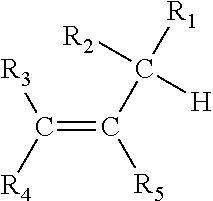Antioxidant composition
- Summary
- Abstract
- Description
- Claims
- Application Information
AI Technical Summary
Benefits of technology
Problems solved by technology
Method used
Image
Examples
example 1
[0295]Determination of Antioxidant Activity
[0296]The aim of this Example is the determination of antioxidant activities in a savoury model system. The model system comprises an oil that is sensitive to oxidation adsorbed on a quantity of kitchen salt in a way that ensures a large air exposure surface for the oils. The calculation of a deceleration factor of the tested antioxidant is based on accelerated rancidity evaluation by sensory assessment using a scale of level 1-5.
[0297]Materials
[0298]Commercially available powders of the herbs and spices in Table 1 were used. For each of the powders, the weight percentage of all particles smaller than 0.5 mm, the weight percentage of all particles smaller than 0.315 mm, and the weight percentage of all particles smaller than 0.2 mm are provided, as determined by the method described below.
TABLE 1Size analysis%-wt %-wt %-wt PowderBotanical namemmmmmmPepperPiper nigrum L.94.285.567.4SageSalvia triloba L.90.286.129.5CloveSyzygium aromaticum81....
example 2
[0318]In this example the effect of the combination of herb and spice powders according to the invention was demonstrated in a typical wet product format.
[0319]Materials
[0320]Water: demineralised water.
[0321]Rapeseed oil ex Cargill (Amsterdam, The Netherlands).
[0322]Sugar: sucrose white sugar W4 ex Suiker Unie (Oud Gastel, Netherlands).
[0323]Salt: NaCl suprasel ex Akzo Nobel (Amersfoort, Netherlands).
[0324]EDTA: Ethylenediaminetetraacetic acid, calcium disodium complex, dehydrate;
[0325]Dissolvine E-CA-10 ex Akzo Nobel (Amersfoort, Netherlands).
[0326]Egg yolk: ex Bouwhuis Enthoven (Raalte, the Netherlands); contains 92% egg yolk and 8% kitchen salt.
[0327]Vinegar spirit 12% ex. Kühne (Hamburg, Germany)
[0328]Spice mix extract: combination of ginger powder (G), sage powder (S), rosemary powder (R), pepper powder (P), and clove powder (C) in a weight ratio of G:S:R:P:C=1.26 to 1.54: 0.9 to 1.1:0.9 to 1.1:0.36 to 0.44:0.18:0.22. The same ginger, sage, rosemary, pepper, and clove powders w...
example 3
[0336]A further set of examples was prepared and analysed using the same materials and following the same procedures as in Example 1, but with the herb / spice contents accodring to Table 7. The high deceleration factors observed for the examples containing all three herbs / spices demonstrate the synergistic deceleration of rancidity by combinations of ginger, sage, and rosemary particles.
TABLE 7GingerSageRosemaryDeceleration(wt-%)(wt-%)(wt-%)Factor3:10.35 0.25 0.25 3.73:20.07 0.05 0.05 20.83:3—0.0250.0252.83:40.035—0.0252.33:50.0350.025—2.23:6——0.0251.83:7—0.025—1.73:80.035——1.2
PUM
 Login to View More
Login to View More Abstract
Description
Claims
Application Information
 Login to View More
Login to View More - R&D
- Intellectual Property
- Life Sciences
- Materials
- Tech Scout
- Unparalleled Data Quality
- Higher Quality Content
- 60% Fewer Hallucinations
Browse by: Latest US Patents, China's latest patents, Technical Efficacy Thesaurus, Application Domain, Technology Topic, Popular Technical Reports.
© 2025 PatSnap. All rights reserved.Legal|Privacy policy|Modern Slavery Act Transparency Statement|Sitemap|About US| Contact US: help@patsnap.com

